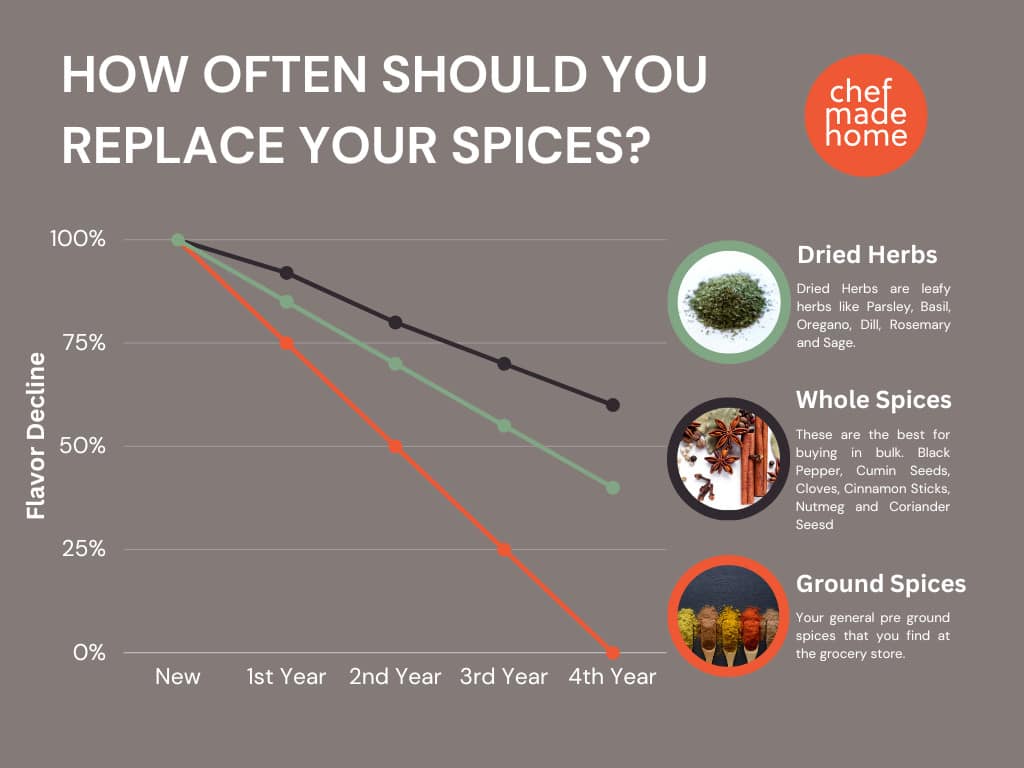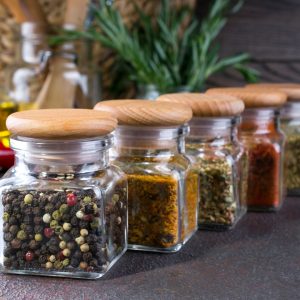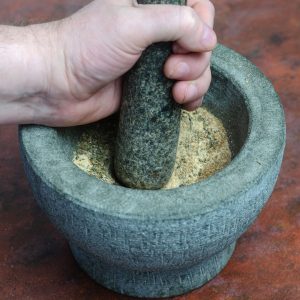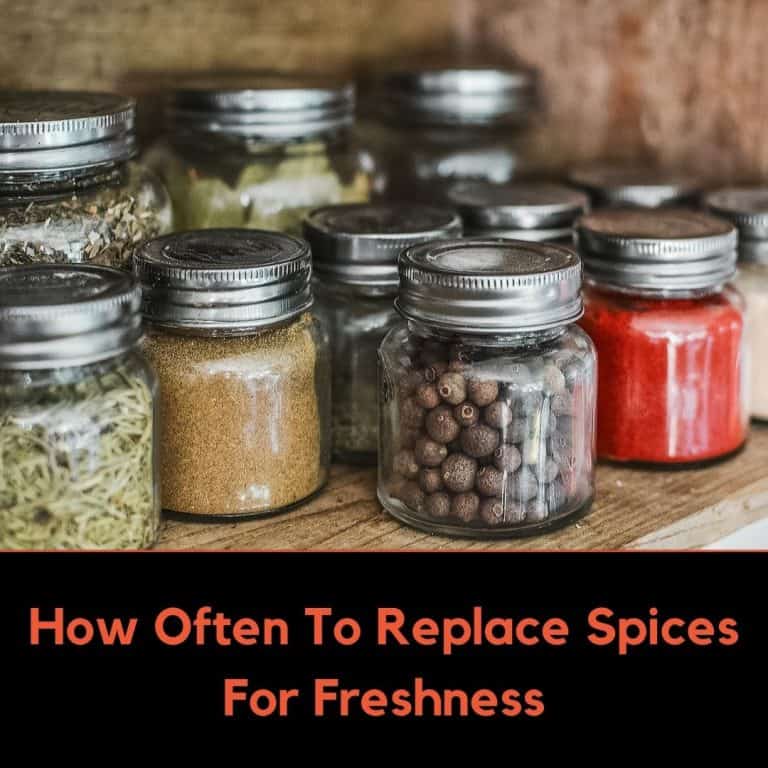Ever opened your spice cabinet and wondered, “How often should you replace spices?” You’re not alone; it’s a culinary query many grapple with. This essential guide dives deep into the lifespan of your favorite spices, answering pressing questions and offering pro-tips on storage, potency indicators, and more. With 27 years as a chef, I’ve seen how spices can make or break a dish. Let’s ensure yours always make the mark.
Where I buy my spices, both for my restaurants and for home: Pendrey’s Spices
How Often Should You Replace Spices?
When we discuss spices, it’s crucial to understand their varying shelf lives, which can directly impact the quality and flavor of the dishes we prepare. Through my 27 years of professional cooking, I’ve gathered some insights:
Whole Spices: These are some of the most enduring. Peppercorns, cloves, cinnamon sticks, and nutmeg, for instance, can be effective for up to 3 years when stored correctly. I’ve always emphasized the importance of using whole spices for longer-lasting aroma and flavor.
Ground Spices: Ground variations like cumin, turmeric, and paprika tend to lose their potency faster, often after 1-2 years. From my experience, pre ground spices “expire” significantly faster.
Dried Herbs: Referring to dried forms such as dried parsley, oregano, basil, rosemary, and thyme, these leafy herbs typically have a shelf life of 1-3 years. After this period, they will have lost their characteristic taste.
Keep in mind that these assumptions are based on perfect storage containers. The reality is that with regular exposure to air, humidity, and light the potent flavor of your spices will degrade quickly. So take a look at how you store your spices now and ask yourself how optimal the set up is.
Bottom line? Time affects them all. And trust me, there’s a world of difference between fresh spices and ones that are past their prime. So, let’s ensure you’re using the best of the best in your kitchen!

Spice Cabinet: Storage Matters
Proper storage of spices is paramount, not just for their longevity, but for maintaining their true essence. Having spent 27 years in the kitchen, I can attest to the significant difference in dishes prepared with well-stored spices versus those that aren’t. Here’s my advice:
Location is Key: Spice bottles need to be stored away from direct sunlight, heat, and moisture. Placing them above the stove or near a window can degrade their quality much faster. I’ve always recommended a cool, dark spice cabinet or pantry for optimal flavor potency over time. So yeah, that means away from the stove even though those small cabinets to the side are the perfect size.
Choice of Container: Over the years, I’ve found that airtight containers, especially those made of glass, are best for preserving the freshness of spices. While plastic spice containers can be used, they may not retain the spice’s potency as effectively over time.
Frequency of Use: Commonly used spices can be kept within easy reach in the kitchen. However, those used less frequently, perhaps for special recipes, should be stored in a more secluded spot to ensure they remain fresh until the next use.
I can’t emphasize enough how crucial it is to store spices properly. It’s a simple act, but it can significantly elevate the quality of your dishes.
Aroma and Color as Indicators for Ground Spices
Ensuring the freshness of spices is essential for achieving the desired flavor in our dishes. Through my extensive experience in the culinary world, I’ve come to rely on two primary indicators:
Aroma as a Guide: One of the most accurate ways to assess the freshness of a spice is through its aroma. A potent, distinct scent typically indicates that a spice retains its quality. Conversely, if its aroma is faint or almost non-existent, it may have lost its effectiveness. I’ve found that a spice without its signature aroma seldom delivers its expected taste. Worst case scenario it actually adds a “dusty” flavor profile. Cayenne pepper and smoked paprika are the most common spices to do this.
Visual Inspection: Just as crucial is the visual aspect. If you find that once vibrant spices like paprika or turmeric appear faded or less vivid it the spice bottle, it’s a clear indication of diminishing potency.
I’ve always emphasized the importance of sourcing spices from trusted suppliers. Starting with a high-quality product is the first step to ensuring the dishes you create are flavorful and authentic. It’s a principle I’ve held close throughout my culinary journey, and it makes all the difference.

Potential Health Concerns
Ensuring the freshness of spices isn’t solely about taste; it’s also about our well-being. In my 27 years of culinary experience, I’ve understood the importance of both the flavor and health aspects of spices.
Flavor and Health Benefits: A spice’s efficacy diminishes as it ages. Consider turmeric: renowned for its anti-inflammatory properties, but as it grows older, it loses some of its benefits. The same applies to other spices. It’s essential to realize that it’s not only about the vibrant flavor but also about harnessing the full health benefits of each spice.
The Risks of Improper Storage: Contrary to popular belief, spices can degrade and become harmful. When spices are stored in damp conditions or exposed to varying temperatures, they become susceptible to mold and bacteria. As a chef, I’ve come across spices that, due to improper storage, were no longer safe to use.
Being Wary of Contamination: On rare occasions, spices have been the subjects of recalls due to the presence of contaminants like Salmonella. This underscores the importance of not only regular rotation of your spices but also sourcing them from reputable suppliers.
Over the years, I’ve come to understand the balance between enjoying the art of cooking and ensuring the safety and health of those for whom I cook. Your spices can indeed elevate a dish or, if not handled correctly, compromise its integrity. Always prioritize quality and safety in your culinary endeavors.
Economic and Sustainability Aspects
Understanding spices is not just about taste; it also involves recognizing their economic and environmental impacts. Here’s what I’ve learned from my years in the kitchen:
Cost Efficiency: Spices, while small, can represent significant expenses over time. It’s tempting to buy in bulk, especially with pricier or organic options. But it’s crucial to consider: if you end up discarding half because it’s stale, are the savings genuine?
Bulk vs. Individual Packs: For frequently used spices like black pepper, red pepper flakes or garlic powder, bulk purchases make sense. But for those unique spices you use occasionally? Opt for smaller quantities. It’s about efficiency and ensuring you utilize what you have.
Considering Sustainability: When you throw away spices, it isn’t just money you’re wasting. Think of the resources – from cultivation to packaging to transportation. Every discarded jar has a more extensive environmental footprint than we often acknowledge.
Minimizing Waste: One principle I’ve always abided by is to purchase only what I can use. If some spices are nearing their expiration, innovate. There’s always a dish that can benefit from an extra sprinkle or two.
In the end, it’s about striking a balance. Proper spice management not only enriches our dishes but also promotes sustainability and economic efficiency. Every choice in our kitchen has ripple effects – it’s essential to make them count.

Decoding the Spice Shelf: Ensuring Freshness in Store-Bought Spices
When you’re in the grocery store, selecting spices can be more nuanced than just grabbing a jar off the shelf. Based on my years in the kitchen, here’s a guide to making sure you’re investing in quality, fresh spices:
Check the Expiry Date: Always start with the expiration or “best by” date. While it doesn’t dictate that the spice will suddenly lose its value after this date, it does give an indication of when the spice’s optimal flavor might diminish.
Assess the Packaging: Opt for spices housed in opaque or dark containers, as these protect the contents from light, which can degrade potency. A label that appears faded can be a sign the container has been on the shelf for an extended period.
Inspect Freshness Seals: Ensure the protective seal under the lid is intact. A broken or missing seal can suggest tampering or extended storage.
Note Lot Numbers: Some manufacturers use lot numbers or even production dates on their packaging. This can be a helpful tool; you can sometimes contact the company for more specifics about when the spice was produced.
Whole vs. Ground: Whole spices tend to retain their potency longer than their ground counterparts. If in doubt, and if you have the tools at home to grind or crush them, opt for whole spices.
Engage Your Senses: While it’s not always possible to open a jar in-store, you can sometimes get a sense of freshness from the scent of a spice through its container, especially if it’s in a bag or loose format.
Consider the Store’s Stock Rotation: Establishments with a higher turnover of products usually offer fresher inventory. Specialty stores or those known for spices can be a good bet for ensuring you are not buying an old spice.
When investing in spices, a little diligence goes a long way. Ensuring the quality and freshness of these ingredients can make a noticeable difference in your culinary creations. It’s always been my belief that the best dishes start with the best ingredients.

Getting Grounded: The Mastery of Grinding Your Own Whole Spices
Embarking on the journey of grinding your own spices offers unparalleled culinary rewards. Drawing from my experiences, I’ll lay out the reasons and techniques for this transformational practice.
The Case for Grinding Your Own Spices:
Boosted Potency: Grinding spices releases their essential oils, the very essence of their flavor and aroma. Freshly ground spices deliver the most potent flavor and depth compared to their pre-packaged counterparts.
Precision and Control: Grinding allows you to determine the texture, whether you want it coarse for certain rustic dishes or finely milled for others.
Versatility: Different dishes may call for varied grinds. Taking charge of this process lets you adapt seamlessly.
Preservation: Whole spices inherently have a longer shelf life compared to ground ones. Grinding on-the-go guarantees optimal freshness.
Essential Tools for the Task:
Mortar and Pestle: A timeless instrument ideal for processing smaller quantities. It’s hands-on and doesn’t rely on power.
Electric Coffee Grinder: While intended for coffee, it’s remarkably effective for spices. To avoid flavor mixing, reserve one solely for spices.
Dedicated Spice Grinder: Engineered specifically for spices, many offer flexibility in choosing the grind size.
Microplane or Grater: Ideal for certain spices like nutmeg or cinnamon.
Refining the Grinding Process:
Pre-Grinding Toasting: Toasting spices, like cumin or coriander seeds, can amplify their flavors. Remember to cool them before grinding.
Routine Cleaning: Residual spices can compromise flavor integrity. Regularly clean your equipment to maintain consistency.
Proper Storage: Fresh grinding doesn’t negate the need for proper storage. Use airtight containers and store them away from direct light and heat.
Drawing from my culinary journey, I assure you that grinding your spices in-house enhances your dishes profoundly. It requires a bit more effort, but the payoff in flavor is indisputable. Embrace the practice; you’ll find the results remarkable.
Frequently Asked Questions (FAQ)
When should you throw away spices?
Spices typically don’t have an exact expiration date, but their potency and flavor degrade quickly over time. Rely on aroma and color as indicators. If they’ve lost their characteristic smell or have visibly faded, it might be time to bid them goodbye. There is also no clear cut answer to how long different spices expire. Buy in small quantities from best results with time.
Is it OK to use old spices?
Using old spices isn’t typically harmful, but they may have lost their flavor punch and health benefits. However, spices stored improperly can harbor mold or bacteria, so always check for signs of spoilage.
Are spices still good after 2 years?
Depends on the spice! Whole spices can last up to 4 years, while ground ones usually start losing their edge after 2-3 years. Dried herbs generally have a shelf life of 1-3 years. Always check for aroma and color changes.
Do spices go bad or expire?
While spices don’t “expire” in the traditional sense, they can lose their potency and may develop mold or bacteria if stored improperly. It’s a myth that they can’t go bad. If they’re exposed to moisture, for example, they can certainly spoil.
How Often Should You Replace Your Spices?
A general rule of thumb:
Whole spices: Every 2 years
Ground spices: Every year
Dried herbs: Every 18 months
Remember, these are general guidelines, and individual results might vary based on storage conditions.
Personally – I label each of my spice jars with the date that I bought them and will replace them, if I still use it, every year. Most of the time though I’m using the smaller containers faster than that so its rarely an issue.
How to tell whether your spices have gone bad?
Trust your senses. If a spice doesn’t smell as potent as it once did or has a faded color, it’s likely past its prime. Also, look for any signs of mold, clumping, or other changes in appearance.
How to Store Spices for Maximum Flavor?
Keep spices in a cool, dark place, away from direct sunlight, heat, and moisture. Airtight or glass containers are ideal. Remember, proper storage is the key to prolonging their life and potency.
I’ve cooked up countless dishes and had my fair share of spice mishaps over the years. Trust me, when it comes to spices, a little knowledge goes a long way in ensuring your dishes are always flavorful and safe!
Key Takeaways
Spices don’t possess a strict expiration date, but their potency diminishes over time. Trust their aroma and color as indicators.
Aged spices aren’t typically harmful, but they can lose flavor and other benefits. Always inspect for signs of spoilage.
The lifespan of spices varies. Whole spices last up to 4 years, ground versions about 2-3 years, and dried herbs between 1-3 years.
Proper storage is paramount. Store spices in a cool, shaded area in airtight or glass containers to ensure their longevity and essence.
Refresh your spice collection today. And for an unparalleled flavor experience, venture into grinding your own spices. Your dishes will thank you!








![AmuseWit Gravity Electric Pepper and Salt Grinder Set [White Light] - Battery Operated Automatic Pepper and Salt Mills,Adjustable Coarseness,One-Handed Operation,Stainless Steel](https://m.media-amazon.com/images/I/51mNkCNrHcL._SL160_.jpg)